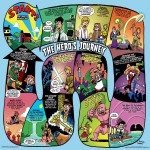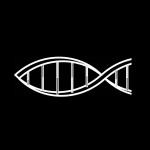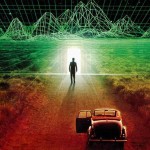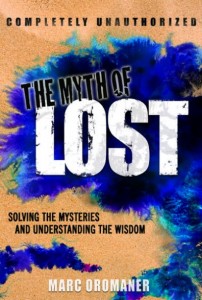 When you’ve seen as many movies as I have, you begin to see that they all follow a certain pattern. This is true not just of movies, but of all great stories ranging from those found in classic mythology and literature to modern TV series and video games. Joseph Campbell called it the monomyth or hero’s journey. It’s basically a series of steps that the protagonist must go through during the course of his or her adventure. In addition to this, there are also a number of spiritual principles that often find their way into storytelling. By combining these principles with the monomyth, you can pretty much figure out where just about any story is headed. While this skill has proven to be incredibly annoying to my wife, it’s come in very handy for me. Not because I’ve continually annoyed her with my usually correct movie and TV show predictions, but because I’ve noticed that these storytelling rules apply to more than just fictitious stories. They also apply to real life.
When you’ve seen as many movies as I have, you begin to see that they all follow a certain pattern. This is true not just of movies, but of all great stories ranging from those found in classic mythology and literature to modern TV series and video games. Joseph Campbell called it the monomyth or hero’s journey. It’s basically a series of steps that the protagonist must go through during the course of his or her adventure. In addition to this, there are also a number of spiritual principles that often find their way into storytelling. By combining these principles with the monomyth, you can pretty much figure out where just about any story is headed. While this skill has proven to be incredibly annoying to my wife, it’s come in very handy for me. Not because I’ve continually annoyed her with my usually correct movie and TV show predictions, but because I’ve noticed that these storytelling rules apply to more than just fictitious stories. They also apply to real life.
 Ah, the enlightened life! A life where the superficial trappings of the material world have lost their luster. Where greasy, fried, and fatty foods are no longer tempting. Where meditation, sharing, and an appreciation of the beauty of nature provide all the fulfillment one needs for true happiness. And yet, considering how healthy, content, and self-fulfilled spiritual people claim to be, why are they plagued with so many health, wealth, and happiness issues? Is poverty a requirement of enlightenment? Is self-indulgence selfish? Is self-love a sign of an inflated ego? The irony is that most spiritual people are just as egotistical as materialistic people—perhaps even more so since they believe themselves to be so far above everyone else. Sacrifice and ascetic behavior do not make one spiritual. Denying the material for the sake of the spirit misses the big picture. To be truly fulfilled, one needs to embrace both of these worlds, creating more than a holy life, but a wholly life.
Ah, the enlightened life! A life where the superficial trappings of the material world have lost their luster. Where greasy, fried, and fatty foods are no longer tempting. Where meditation, sharing, and an appreciation of the beauty of nature provide all the fulfillment one needs for true happiness. And yet, considering how healthy, content, and self-fulfilled spiritual people claim to be, why are they plagued with so many health, wealth, and happiness issues? Is poverty a requirement of enlightenment? Is self-indulgence selfish? Is self-love a sign of an inflated ego? The irony is that most spiritual people are just as egotistical as materialistic people—perhaps even more so since they believe themselves to be so far above everyone else. Sacrifice and ascetic behavior do not make one spiritual. Denying the material for the sake of the spirit misses the big picture. To be truly fulfilled, one needs to embrace both of these worlds, creating more than a holy life, but a wholly life.
 For years leading up to 2012, spiritual-types who were sick of the way the world was heading could take comfort in the promise of a new era that was predicted to begin on December 21 of that year. The Mayans, known for their astronomical expertise had supposedly predicted it. In addition, St. Malachy’s famous Prophecy of the Popes, which predicts when the world as we know it would end, also correlates to about the same time period. The Hopi tribe, Edgar Cayce, a book attributed to Nostradamus, hell, even The History Channel’s countless specials all pointed towards 12/21/12 as the beginning of the end times. The details differed, but whether you believed that Earth was due for a major cataclysm, a spiritual awakening, a religious reckoning and rapture, an alien visitation, a new dimension, or just an enlightened age, most people seemed somewhat excited that a major event was on the horizon. When the day finally arrived, we instead got something that came as a shock to many: absolutely nothing. Or so it would seem.
For years leading up to 2012, spiritual-types who were sick of the way the world was heading could take comfort in the promise of a new era that was predicted to begin on December 21 of that year. The Mayans, known for their astronomical expertise had supposedly predicted it. In addition, St. Malachy’s famous Prophecy of the Popes, which predicts when the world as we know it would end, also correlates to about the same time period. The Hopi tribe, Edgar Cayce, a book attributed to Nostradamus, hell, even The History Channel’s countless specials all pointed towards 12/21/12 as the beginning of the end times. The details differed, but whether you believed that Earth was due for a major cataclysm, a spiritual awakening, a religious reckoning and rapture, an alien visitation, a new dimension, or just an enlightened age, most people seemed somewhat excited that a major event was on the horizon. When the day finally arrived, we instead got something that came as a shock to many: absolutely nothing. Or so it would seem.
 Ever since Darwin published his infamous On the Origin of the Species in 1859, science and theology have been at war over the theory of evolution. The irony is that evolution and all its aspects—natural selection, survival of the fittest, genetic mutations—all appear in the Bible as clear as day. In fact, even the missing link of the explanation that science has still not uncovered appears in there as well. Is it found in some lost book, obscure passage, cryptic verse, or esoteric translation? No, it appears in an entire story that everyone knows—the story of Noah’s Ark. And once I point out the metaphoric meaning of the story, you’ll wonder how on earth you never noticed it before. How? The church didn’t want you to notice. Because the truth takes power away from them and puts it where it rightfully belongs—to you.
Ever since Darwin published his infamous On the Origin of the Species in 1859, science and theology have been at war over the theory of evolution. The irony is that evolution and all its aspects—natural selection, survival of the fittest, genetic mutations—all appear in the Bible as clear as day. In fact, even the missing link of the explanation that science has still not uncovered appears in there as well. Is it found in some lost book, obscure passage, cryptic verse, or esoteric translation? No, it appears in an entire story that everyone knows—the story of Noah’s Ark. And once I point out the metaphoric meaning of the story, you’ll wonder how on earth you never noticed it before. How? The church didn’t want you to notice. Because the truth takes power away from them and puts it where it rightfully belongs—to you.
 Supposedly, nobody ever said life was fair. Well, I’m saying it right now. Maybe I’m a nobody so the adage still works but I’ve come to believe that life is absolutely fair. Yes, there are selfish jerks who seem to be rewarded while truly good, hardworking, selfless people seem to be punished. There are people who’ve lived like there’s no tomorrow that live long, healthy lives while people who ate healthy, exercised and did everything right have died young. There are innocent children who suffer with terminal illness while evil dictators enjoy the good life. So how is it that I can possibly believe that life is fair? Because most people only see life on a superficial level, but it’s time that we dig a little deeper.
Supposedly, nobody ever said life was fair. Well, I’m saying it right now. Maybe I’m a nobody so the adage still works but I’ve come to believe that life is absolutely fair. Yes, there are selfish jerks who seem to be rewarded while truly good, hardworking, selfless people seem to be punished. There are people who’ve lived like there’s no tomorrow that live long, healthy lives while people who ate healthy, exercised and did everything right have died young. There are innocent children who suffer with terminal illness while evil dictators enjoy the good life. So how is it that I can possibly believe that life is fair? Because most people only see life on a superficial level, but it’s time that we dig a little deeper.
 You’ve seen it hundreds of times. Some guy is being interviewed by the local news after he helped prevent some crime or rescued someone in distress. The reporter asks, “Do you consider yourself a hero?” Apparently, this question must be asked in order to test whether or not said person is in fact a hero. According to local news rules of heroism, the man is only a hero, if and only if, he claims to not be one. Most people, knowing this rule, go on to say that they don’t consider themselves to be a hero because they just did what anyone in their situation would’ve done. The reporter then cuts back to the anchorpeople who disagree with the man’s assessment. Feeling that the hero test was passed, they comment about what a true hero the man is while a colorful “local hero” graphic displays besides them. Personally though, I agree with the guy. He’s not a hero.
You’ve seen it hundreds of times. Some guy is being interviewed by the local news after he helped prevent some crime or rescued someone in distress. The reporter asks, “Do you consider yourself a hero?” Apparently, this question must be asked in order to test whether or not said person is in fact a hero. According to local news rules of heroism, the man is only a hero, if and only if, he claims to not be one. Most people, knowing this rule, go on to say that they don’t consider themselves to be a hero because they just did what anyone in their situation would’ve done. The reporter then cuts back to the anchorpeople who disagree with the man’s assessment. Feeling that the hero test was passed, they comment about what a true hero the man is while a colorful “local hero” graphic displays besides them. Personally though, I agree with the guy. He’s not a hero.
 Back in June 2009, I wrote an article titled “Proof That We’re Living a Life of Illusion.” In it, I provided what I felt was overwhelming evidence that we all live in some kind of computer simulation. I also offered some simple explanations as to why I thought we did. At the time, the people who are open to believing in such fantastical theories excitedly agreed with the premise, while those who rely on hard-core scientific proof, did not. Well, a funny thing’s happened in the years since I wrote that article. Scientists are beginning to see the evidence that the non-believers require. The question now is, whether those skeptics will decide to take the blue pill or the red pill?
Back in June 2009, I wrote an article titled “Proof That We’re Living a Life of Illusion.” In it, I provided what I felt was overwhelming evidence that we all live in some kind of computer simulation. I also offered some simple explanations as to why I thought we did. At the time, the people who are open to believing in such fantastical theories excitedly agreed with the premise, while those who rely on hard-core scientific proof, did not. Well, a funny thing’s happened in the years since I wrote that article. Scientists are beginning to see the evidence that the non-believers require. The question now is, whether those skeptics will decide to take the blue pill or the red pill?
 There is certainly no shortage of theories about what may or may not happen on December 21. Of course, nearly all of them will turn out to be wrong. My experience has shown however, that there is one thing you can do that will likely be beneficial regardless of what’s in store for us: think positive.
There is certainly no shortage of theories about what may or may not happen on December 21. Of course, nearly all of them will turn out to be wrong. My experience has shown however, that there is one thing you can do that will likely be beneficial regardless of what’s in store for us: think positive.
 The ancient world has left us with lots of mysteries that have been baffling mankind for millennia. Mysteries like the Great Pyramid of Giza, Stonehenge, the Crystal Skulls, the Nazca Lines, and many more. In addition, our history is filled with unanswered questions about who we are, what inspired the stories of our gods, what all this extra DNA is doing in our genes, and so on. What if I told you that all of these seemingly unrelated mysteries all share the exact same explanation—and that this explanation will completely change life on earth as we know it? Oh, and the epiphany for this explanation hit me while I was watching a horror movie that came out earlier this year. This movie’s tagline was, “You think you know the story. Think again.” The same can be said of this edition of “Answers to Everything.”
The ancient world has left us with lots of mysteries that have been baffling mankind for millennia. Mysteries like the Great Pyramid of Giza, Stonehenge, the Crystal Skulls, the Nazca Lines, and many more. In addition, our history is filled with unanswered questions about who we are, what inspired the stories of our gods, what all this extra DNA is doing in our genes, and so on. What if I told you that all of these seemingly unrelated mysteries all share the exact same explanation—and that this explanation will completely change life on earth as we know it? Oh, and the epiphany for this explanation hit me while I was watching a horror movie that came out earlier this year. This movie’s tagline was, “You think you know the story. Think again.” The same can be said of this edition of “Answers to Everything.”
 Have you seen them? They’re everywhere: in movies and TV shows, on ads and product packaging, in architecture, design, floor patterns, the Olympics, online, and even on the paper wrapped around hero sandwiches. They are honeycombs and hexagons, and they are taking over. Sure, design styles come and go, but why has this one seemed to have popped up so suddenly, become so incredibly prolific, and been so invisible to so many? Of course, now that you’re in the know, you’ll begin seeing them too (if you haven’t already). The question is why are they here, what do they mean, and why should you care?
Have you seen them? They’re everywhere: in movies and TV shows, on ads and product packaging, in architecture, design, floor patterns, the Olympics, online, and even on the paper wrapped around hero sandwiches. They are honeycombs and hexagons, and they are taking over. Sure, design styles come and go, but why has this one seemed to have popped up so suddenly, become so incredibly prolific, and been so invisible to so many? Of course, now that you’re in the know, you’ll begin seeing them too (if you haven’t already). The question is why are they here, what do they mean, and why should you care?
 When you’ve seen as many movies as I have, you begin to see that they all follow a certain pattern. This is true not just of movies, but of all great stories ranging from those found in classic mythology and literature to modern TV series and video games. Joseph Campbell called it the monomyth or hero’s journey. It’s basically a series of steps that the protagonist must go through during the course of his or her adventure. In addition to this, there are also a number of spiritual principles that often find their way into storytelling. By combining these principles with the monomyth, you can pretty much figure out where just about any story is headed. While this skill has proven to be incredibly annoying to my wife, it’s come in very handy for me. Not because I’ve continually annoyed her with my usually correct movie and TV show predictions, but because I’ve noticed that these storytelling rules apply to more than just fictitious stories. They also apply to real life.
When you’ve seen as many movies as I have, you begin to see that they all follow a certain pattern. This is true not just of movies, but of all great stories ranging from those found in classic mythology and literature to modern TV series and video games. Joseph Campbell called it the monomyth or hero’s journey. It’s basically a series of steps that the protagonist must go through during the course of his or her adventure. In addition to this, there are also a number of spiritual principles that often find their way into storytelling. By combining these principles with the monomyth, you can pretty much figure out where just about any story is headed. While this skill has proven to be incredibly annoying to my wife, it’s come in very handy for me. Not because I’ve continually annoyed her with my usually correct movie and TV show predictions, but because I’ve noticed that these storytelling rules apply to more than just fictitious stories. They also apply to real life.










